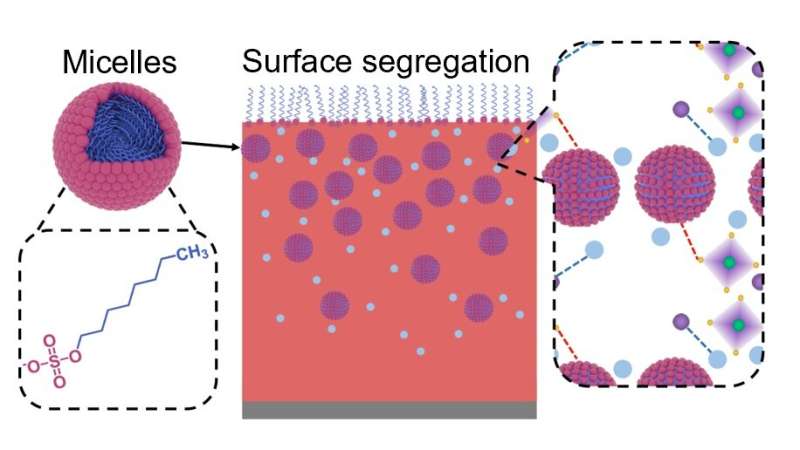
Prof. Ye Jichun’s team at the Ningbo Institute of Materials Technology and Engineering (NIMTE) of the Chinese Academy of Sciences (CAS) has developed a long-alkyl- chain anionic surfactant (LAS) additive that can significantly improve the long-term operational stability of perovskite/silicon tandem solar cells. The study was published in Nature Communications.
Thanks to the rapid development of the power conversion efficiency (PCE), which has jumped from 13.7% to 33.2% over the past eight years, perovskite/silicon tandem solar cells have a promising future. However, the relatively low stability of perovskite active layers still hinders the development and commercialization of perovskite/silicon tandem devices.
Traditional methods to improve the stability include encapsulation, crystallization engineering, and defect passivation. Similar to “stress corrosion” in metals, glass and polymers, subcritical perovskite deterioration inevitably occurs due to tensile stress during the fabrication and operation, which degrades device performance.
To suppress the “stress corrosion,” the researchers developed a novel LAS additive for the perovskite/silicon tandem solar cells.
By virtue of the surface segregation and micellization, the LAS additive can chemically modify the perovskite crystallization kinetics. Additionally, it can physically form a glue-like scaffold to eliminate the residual stress.
Due to the reduced defects, suppressed ion migration, and improved energy level alignment, the unencapsulated perovskite and perovskite/silicon tandem solar cells exhibited excellent operational stability.
Under continuous light illumination, the LAS-modified single-junction perovskite and dual-junction perovskite/silicon tandem devices can retain 85.7% and 93.6% of their original PCE after 3,000 hours and 450 hours of maximum power point tracking, respectively, which are among the best stabilities reported to date under similar conditions.
The innovative approach of this study may provide insight into the commercial production and large-scale application of highly stable perovskite/silicon tandem solar cells.
More information:
Xinlong Wang et al, Long-chain anionic surfactants enabling stable perovskite/silicon tandems with greatly suppressed stress corrosion, Nature Communications (2023). DOI: 10.1038/s41467-023-37877-z
Citation:
Novel additive helps improve stability of perovskite/silicon tandem solar cells (2023, April 25)
retrieved 25 April 2023
from https://techxplore.com/news/2023-04-additive-stability-perovskitesilicon-tandem-solar.html
This document is subject to copyright. Apart from any fair dealing for the purpose of private study or research, no
part may be reproduced without the written permission. The content is provided for information purposes only.
Stay connected with us on social media platform for instant update click here to join our Twitter, & Facebook
We are now on Telegram. Click here to join our channel (@TechiUpdate) and stay updated with the latest Technology headlines.
For all the latest Technology News Click Here
For the latest news and updates, follow us on Google News.
